#because there’s nothing more healing to the soul than Studio Ghibli movies
Text
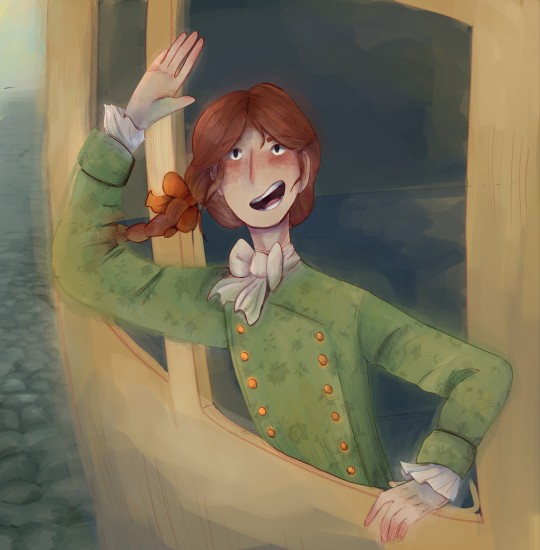
Sometimes you gotta draw some wholesome Clerval fanart to cheer yourself up.
#My initial idea was just Henry arriving at Ingolstadt but it’s Studio Ghibli#because there’s nothing more healing to the soul than Studio Ghibli movies#and I need that a lot right now#who knew preparing a presentation about rococo art would take multiple days to finish#I know I'm rambling again but I have this presentation next week#after days of research I still have nothing and I only have about one day to finish it#Frankenstein#the modern prometheus#frankenstein fanart#henry clerval#fanart#art
25 notes
·
View notes
Text
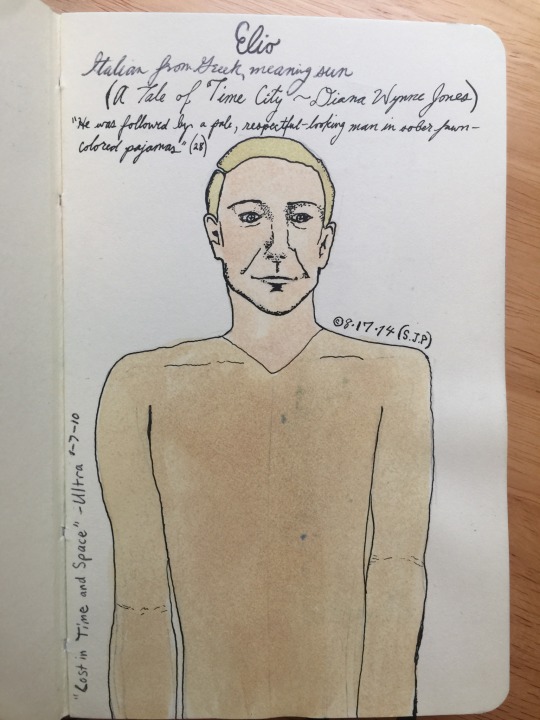
A Tale of Elio and My Fixation with Lovable Androids
TL;DR Feel free to scroll past this unless you’re keen to read my ramblings about androids, Neoclassical art, children’s lit, and bad science fiction movies.
Since the late 1990s one of my favourite books has been A Tale of Time City (1989) by Diana Wynne Jones. It’s a mildly confusing story but engaging, with memorable characters, including the android Elio, pictured above - my own fan art from a few years ago. Studio Ghibli really needs to make this film if no one does a live-action version, seeing as they brought Jones’ novel Howl’s Moving Castle to life. Here’s a scan of my favourite edition with mesmerizing cover art by Richard Bober.

This book inspired me so much I’ve done research on it. I wasn’t in a class in grad school that allowed me to write about it so I took it on as a casual independent project in 2019. Two days after my dad died of cancer I was scheduled to present my paper on Elio from ATOTC. Needless to say I was not able to finish writing the essay. I told the department coordinator I would likely not attend but I would let him know. He was seriously surprised that I showed up. I must have looked like a ghost - wearing a nice top, skirt, tights, and short heels. I was still in total shock but I thought I might as well press on. My paper’s working tile remains as it was: Elio: Android Autonomy and the Personification of the Sun God. I presented a long bullet point list of working ideas and research done up until that point. My work is still on the broad side because it’s an intersection of young adult fiction, Neoclassic art, and android autonomy; I have some narrowing to do. Here are my main arguments thus far:
Firstly, the android character Elio’s physical characteristics and personality are inspired by Helios, the Hellenistic Greek god and personification of the sun. Apparently, Elio is a Spanish name meaning sun and also an Italian given name referring to the element helium, originally derived from the Greek name of the sun-god Helios.
Secondly, Elio and Helios share more than an etymological connection and the comparison of Elio to Helios can be articulated in two distinct ways: the aesthetic comparison, and that Elio possesses some of the qualities Helios is known for. Jones’ work repeatedly associates Elio with sunlight and golden hues, aspects which are exemplified in the 1765 Neoclassical painting Helios as the Personification of Midday by Anton Raphael Mengs. (I vaguely remember translating a couple passages from a large art book written in German when I was studying Neoclassical art.)
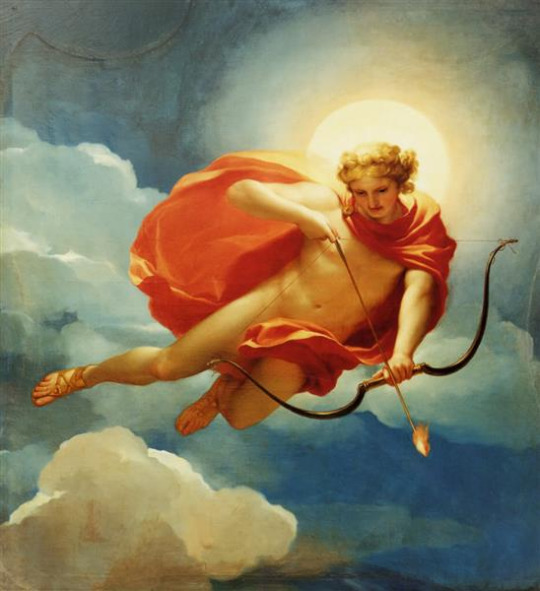
This work is considered an unusual depiction of Helios. Mengs uses a motif of the glowing arrow which is interpreted by François-Xavier Fabre as a symbol of the midday heat and the sun's rays which penetrate and give light to the earth. The representation of the sun in this way is considered unusual for the 18th century because it goes against Classical and Baroque iconography which portrays Helios riding a chariot. Ironically, Jones references this. Elio proclaims his fondness for films, particularly the chariot race from Ben Hur. Elio, like Mengs’ depiction of Helios, lacks a chariot but retains his beauty and powers.
As for Elio possessing some of the qualities of Helios, the god is often referred to as “all seeing” or “Zeus’s eye.” Similarly, Elio has the ability to anticipate problems and see what humans do not, but not because he’s a god, but because he’s a servant. However, this is where his self governing comes into play when he uses his observations to take action beyond any directives he has been given. His physical strength, like Helios, exceeds that of humans. Elio himself says, “my utmost is more than twice that of a born-human” (Jones, 211).
Thirdly, Elio’s self awareness allows him to use both his powers of observation and superior physical strength independent from humans. He does not always wait to be told how to use his power; he wields it. Not only does he play a part equal to that of humans in Jones’ plot, he specifically controls the fates of certain human characters. For example, he doesn’t always utilize his speed when he’s at the beck and call of his master, Sempitern. He makes choices not to fully comply with the demands made of him.
My fourth point, which I can’t quite articulate well, is that the most significant dynamic of this comparison is the body of Elio and how his physicality interacts with his autonomy. Elio acts as an individual who contributes to a wider mythology just as Helios does. Yet, while Elio is superior to humans in many ways, his quasi-humanity allows him to act in ways which align with Helios’ qualities.
For example, Elio makes personal choices and exhibits emotions not necessary for him, as an android, to function. He confesses a desire to harm another android out of annoyance where a passionate opinion would not be expected from an android. This human failing is indicative of the same autonomy which allows him to act as Helios does. Elio has been constructed as a superhuman body in terms of his abilities, however, the human qualities which contribute to his Helios-like powers undermine his intended purpose.
Ultimately, Elio ascends the usefulness of his “owned” body by acting independently from the humans who utilize him. His human qualities make him vulnerable and therefore he loses some of his godlike powers. Elio, while only an assistant to his human owners, utilizes his own physical and mental powers to maintain his autonomy. Conversely, his god-like qualities make Elio more human rather than affirming his android identity.
This is a very complex subject and I don’t really know where I’m going with it and have possibly made some suppositional errors. TL;DR: What I do know is that Elio presents a paradox: being idealized for his abilities allows him to be autonomous while being autonomous disrupts the servitude of his body.
I am in the process of determining what lens I will use to analyze Elio’s experience and functionality of being an android. I’m thinking about using Alan Turning’s 1950 work Computing Machinery and Intelligence. I’m still navigating the literary theory aspect, or indeed philosophical aspect, of this area of study.
This brings me to something I came across later that relates to Elio and ATOTC.
SPOILERS AHEAD

The closest depiction of an android that I’ve seen to Elio other than Data is from a terrible and somewhat forgotten science fiction film from 1989. “Byron”, (played by pre-Jurassic Park-fame Bob Peck) the android in the painfully awful film Slipstream comes very close to Elio in terms of tone, attitude, and characterization. Despite the embarrassingly bad script and dialogue, Peck does a bang-up job, seemingly acting in a wonderful film running parallel to the absolute trash his co-stars were apparently “acting” in. Yes, I rewatched this film just to write this analysis. (The secondhand embarrassment is off the charts and I had it playing at a low volume most of the time Byron was not on the screen.)
When you first see Byron he’s acting out autonomy but you’re not aware he’s an android. The audience is told he’s an escaped fugitive, a murderer, and that’s all we know for over half the film. Yet there are several clues. When you first see him he’s running over rugged terrain in a suit which was kind of a big hint but nothing makes sense in this film so I just thought that it was a weird costume choice. Then he’s literally shot with a grappling hook. He doesn’t seem to be in pain even though he’s shocked by it, and then is pulled down by a bounty hunter named Tasker (Mark Hamill) and hits the ground from a great height and doesn’t die. He just quotes what I think is John Gillespie Magee, Jr.’s "High Flight”: “I have slipped the surly bonds of Earth….and touched the face of God.” Next time you see him, he’s in handcuffs, looking super depressed, and apparently not bleeding out from the now absent grapple hook that’s gone through his forearm.
He eventually quotes Lord Byron to cryptically indicate his name which is lost on Bill Paxton’s character, Matt. “Byron” essentially means cowshed. It’s ironic because Byron the android is in many ways a receptacle of knowledge. Matt even says sarcastically, “Well aren’t you a walking storeroom of information,” and Byron responds cheerfully, “Yes.”
Byron breaks out of his handcuffs saying they’d “become rather superfluous.” You think he’s just showing off but once you know he’s an android you know he’s just honest all the time. He then heals a blind child and paraphrases Psalm 127:3. Matt says, “I didn’t know you were a healer.” Apparently Byron can perform cataract surgery in less than five minutes. Along their journey together (Bill is set on collecting the bounty on Byron’s head before Tasker can catch up) they camp out. Byron sleeps with his eyes open. (Even if he is an android wouldn’t his eyes need to be “cleaned” in the same way humans need to close our eyes and blink?) Matt wakes up to find Byron seemingly strangling him. “I was feeling your carotid pulse,” he explains. “I was just checking for arrhythmia and episodes of ventricular tachycardia.” At this point you realize he’s not so much a spiritual healer as a doctor who philosophizes a lot.
Byron’s miraculous behavior and pontificating is called into question by a nomadic spiritual community which has been torn apart by an attack on their village. As he lays dying, Ben Kingsley’s character calls Byron a “false prophet” but his faith in this stranger is somewhat restored when he says, “all that will be left of me is bits of gold in the sand. You have a soul, do not abandon it in death.”
Another character says, “The stranger is no mortal man.” Therefore it is clear that Byron likely isn’t human. We don’t find out he’s an android until 46 minutes into the film. Once that’s cleared up, other concepts arise in the script. While not well executed, they are really interesting; emotion both positive and negative, free will, perfection, A.I. slavery, and murder are all addressed throughout the second half of the film. Byron says he doesn’t understand “hate” in context of his “master” to whom he was nurse, brother, father, mentor, and friend, but he admits he was more of a slave than anything else.
The character Ariel takes an interest in him for a variety of reasons, especially romantically. In one very evocative moment we see Byron in a museum exhibit, a false garden of Eden, full of fake vegetation and taxidermies, full body mounts. So we’ve got an android having an Adam experience. Whether or not he experiences “original sin” with Ariel or if he’s “fully functional” is never acknowledged. Although one woman says, “Amanda slept with a robot?!” (who the f**k is Amanda?!) and a man says to another sitting next to him, “I hear they’re rather mechanical in the saddle.”
Byron is less concerned with consummation and more excited about love, sleep, and dreaming. When he is with Ariel he doesn’t quite know how to act in terms of sexual play and then apologizes: “I’m not accustomed to being loved.” We see him closing his eyes when he’s cuddled up with Ariel; the next day he is certainly very pleased that he fell asleep with his eyes closed and had a dream.
In terms of his servitude and autonomy they did not spend an adequate portion of the exposition on it. Matt has a change of heart and says instead of collecting the bounty, he’ll set him free as it’s briefly revealed that Byron killed his “master” upon the man’s request. Naturally, this brings up a lot of confusing feelings for Byron. “Is this what it’s like to be human? I don’t think I’m up to it,” he says. “Can I be trusted with human feelings?” And in a way he cannot. Ariel is brutally shot by Tasker.
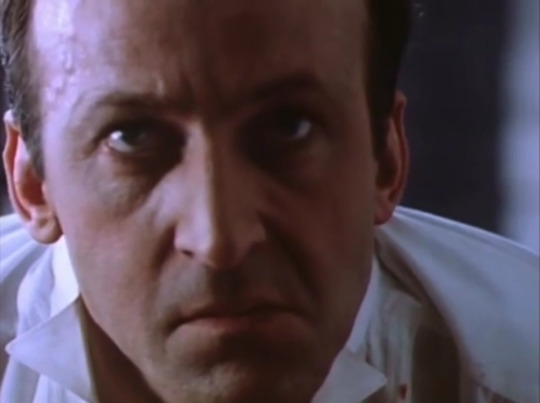
Byron is angered over Ariel’s death and follows the bounty hunter to his ship. Instead of taking him in to collect a reward, Tasker tries to run him down with the glider plane. Byron manages to get himself caught in the engine and starts to strangle his assailant. Tasker quotes “touched the face of god” which brings Byron to his senses and he stops killing Luke Skywalker Tasker and tries to save the plane. It looks like he’s going to hot-wire it but then uses the wires like reins (chariot imagery???). They crash into the side of a mountain slope. Tasker dies but Byron survives. Apparently he’s basically indestructible and somewhat godlike. “I’m too dangerous to be human,” Byron tells Matt. In the end, he goes off in search of the place he’d been dreaming about.
Although in terms of physical appearance the two androids are vastly different, they have so much in common. Here are some basic concepts.
Character: Both are stoic, formal, intelligent, honest
Indestructible: Byron is injured with a grappling hook, takes a major fall of about 20 or 30 feet without a scratch: he is somewhat godlike or slave-like, meant to withstand destruction and pain. Elio is less indestructible but easily repaired.
Healer: Byron has the skills to heal people with basic surgery. Elio doesn’t take his own injuries seriously and experiences pain for the first time (Jones, 218-9).
Both think they deserve to be punished: Elio states this quite clearly (Jones, 276) and Byron says the same thing about himself with resigned passivity.
Complex relationship with “human emotions”: Both come to terms with violence, anger, and love.
Autonomy: At the end of the film Byron goes off on his own to look for a promised land. Elio decides his own fate by deciding to accompany the children of the story, stating that Vivian is a “particular favorite” of his (278).
Dreaming and stories: Byron is searching for a place, “where I think I belong,” he says, which is a place he often thinks and dreams about. Dreaming is considered to be a human attribute, a non-essential bi-product to consciousness. Elio enjoys stories and old films (Jones, 180), similarly “human” in nature.
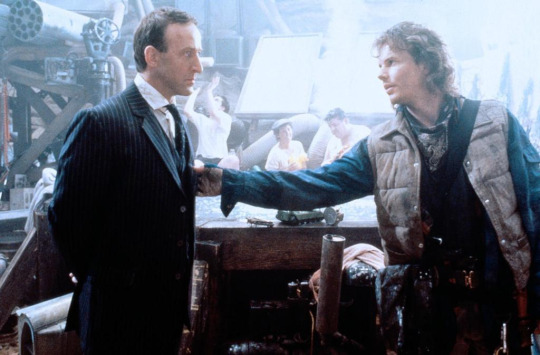
(Peck, seen here waiting for Bill Paxton to learn how to act. Sorry, I’m salty.)
Disclaimer: This is a work in progress! This project is an intersection of niche subjects that interest no one but myself.
Anyway, my point is (yes, I did have a point...or rather several) was that if anyone should adapt A Tale of Time City, Byron from Slipstream is the best example of how Elio should be portrayed in terms of characterization. I feel that Slipstream should have been centered around Byron. The film was kind of like, just about the “we’re both fighting over the bounty of this fugitive” sorta thing. It would have made more sense to focus on Byron as he is arguably the most interesting character and represents many of the conflicts within the story. I would like to combine my research on ATOTC and Slipstream one day. In any case, this is a good start.
Works Cited (WIP)
Jones, Diana W. A Tale of Time City: Knopf, 1987. Print.
Perkowitz, Sidney. Digital People: From Bionic Humans to Androids. Washington, D.C: Joseph Henry Press, 2004. Print.
Roettgen, Steffi, and Anton R. Mengs. Anton Raphael Mengs: 1728-1779 Part 2. München: Hirmer, 1999. Print.
Turing, A. M. “Computing Machinery and Intelligence.” Mind, vol. 59, no. 236, 1950, pp. 433–460. JSTOR, www.jstor.org/stable/2251299.
Wilson, Eric. The Melancholy Android: On the Psychology of Sacred Machines. Albany: State University of New York Press, 2006. Print
#A Tale of Time City#Diana Wynne Jones#my artwork#fan art#art#grad school adventures#Slipstream#c3po#neoclassic art#tldr#long post#personal#Richard Bober#book cover#my scans#my fan art#Bob Peck#1989#my edits#androids#writing#essay#grad school#AI
35 notes
·
View notes
Text
Analysis of My Favourite Panel
A dumbfounding moment, will leave a person completely glued to a floor or a chair. This is just one of the powerful experiences that storytelling gives to a reader.
One of the interesting parts of powerful storytelling lies with a creator or an artist having the ability to convey a message in a clear, but subtle manner. The message is woven and fashioned from numerous tools in the creator’s mind. To a creator they can have multiple messages which are little pieces of a puzzle that are carefully littered onto the page.
When the phrase or image is executed onto the blank paper, page or canvas, it begins a story.
It is placed strategically with a mission and when found by a reader they become obsessive. Sometimes they sit quietly in a room with a reflective silence hanging like a cloud over their head, or they desperately seek for camaraderie. Sweet elation oozes from the body, the reader’s eyes glow and they devour the piece over and over with a fusion of emotions traveling in and out of the body, mind and soul.
A fragment of a story becomes a part of the reader’s existence, sometimes for a short period and in other times, it stays for good.
However, there is no peace for the treasure that has been found.
In fact, the piece is held captive in the reader’s laboratory dissected and examined, again and again. Until the reader reaches the core. Upon reaching the core, the reader pushes forward probing for more answers till the core is cracked.
Then in the moment of awe and confusion, the reader will ask, “Why?”
The question “why” transforms into a tool that aids the reader to become aware of their visceral emotions. Hence, when these emotions are explored within the reader, they become guides which helps them to understand and interpret the creator’s material, eventually assisting them to forge a connection with the characters and the story in the end.
A particular panel in chapter 24, of Saezuru Tori wa Habatakanai when considered, appears at first glance that nothing of substance is taking place. Yet, when explored, it reveals more than just two characters sharing a space. In fact, this space becomes a symbolic entity representing the healing and change that both characters must go through.

To begin with, the setting takes place in Doumeki’s apartment, but the metamorphosis of the two characters is undertaken in Doumeki’s room. A room can represent the disposition and psyche of a character. Yet, there is something peculiar about this room. The room just like the apartment is empty, consisting of no items that reflect Doumeki’s identity and personality. The simplicity of the room strips the reader of any expectations. When the expectations have been dropped consciously by the reader: it allows the character to tell their story. Therefore, the bareness of his room expresses unpredictability and a slight tinge of danger. The room throws back a question to the reader, who is Doumeki?
As the two characters begin to share this intimate moment with each other, simultaneously the weather mirrors the room’s symbolism as well. Therefore, the rain represents a metaphorical symbolism of a healing and restoration of two broken individuals that have been battling their wars all alone.
In one way they are like withering plants slowly dying from an absence of water that gives nourishment. In another instance both these characters share a parallel characteristic with one of the characters from Spirited Away (Studio Ghibli Movies), No Face.
The character of No Face experiences two extreme events that shape his nature, firstly his experience in Yubaba’s Bathhouse and finally, Zeniba’s cottage. The twin witches that symbolize the duality of human existence.
The viewer is subtly shown when a change occurs within No Face by the use of the water element and the surroundings of his environment. Firstly, before entering the Bathhouse, Yubaba’s business establishment, No Face is standing in the pouring rain, before Chihiro allows him inside.
In the Bathhouse No Face embodies the personalities of the Bathhouse’s employees, eventually becoming a grotesque creature. However, upon leaving Yubaba’s business establishment, No Face throws himself into the river as he desperately tries to catch up to Chihiro. In the process he is completely washed in the river.
In the end when they arrive at Zeniba’s simple cottage, No Face has a different air to him, he is finally at peace with himself and finding contentment in Zeniba’s home.
Zeniba’s home is different. The simplicity of her cottage leads a viewer to making a false assumption of Zeniba’s character. Initially, it can connote that her character is plain and simple. However, when entering the home there is unique atmosphere, consisting of warmth and tranquillity. In the same way Zeniba’s cottage can be paralleled to Doumeki’s apartment. Suggesting that there is more to this character than what meets the eye.
Hence, the combination of the room and the rain translates to the creation of a special world that these two characters share secretly. A world where they are seeking a balance of themselves.
The panel shows how this balance is being achieved, it involves the actions between the two characters and their importance to the story. These actions are: Doumeki hanging Yashiro’s wet clothing, Yashiro having covered himself in Doumeki’s duvet, Yashiro remaining seated, Yashiro sniffing and the silence of the room.
Firstly, by having Doumeki hang Yashiro’s clothing this figuratively symbolizes how Doumeki desires to adorn himself with Yashiro. To Doumeki this represents how he sees Yashiro and to him Yashiro is someone he longs for with great power. Therefore to Doumeki, Yashiro adds colour to his plain world. However, this action can also symbolize the hanging of a façade in terms of Yashiro. This persona that Yashiro has created poses the same question that the reader had to Doumeki. However now it asks Yashiro (“who is he”?), without the Yakuza clothes.
Secondly, Yashiro covering himself with Doumeki’s duvet is similar to how Doumeki hangs the clothes. It highlights Yashiro’s needs and desires as well. However this action contradicts the belief system of Yashiro. He is a character that has relied on protecting himself and it appears that this belief system has been reinforced by the traumatic experiences he has gone through.
Hence by consciously deciding to drape himself with Doumeki’s duvet he is inadvertently at odds with himself, in consequence, he is going against the fortified behaviours that have aided him in surviving. Hence, another question that his façade can ask him is whether he should continue to survive? Throughout his life he has been a character that has only been surviving, hence if he stopped surviving what would it mean to his life, because survival is something he excels in.
Therefore by deciding to go against this belief system Yashiro is asking for something more. However, by asking for an alternative he is seeking for a reason that is outside of his experience. By settling to remain seated this action strengthens this idea, since he does not try to dominate the situation by standing.
Consequently, it reveals a personality trait that Yashiro has been hiding and that is of fragility. His figure in the panel looks small, uncertain and scared. This highlights his fears of being lost in an unknown situation. The shading of the two characters in different tones cements the theme of fragility with Yashiro shaded in a grey tone, while Doumeki and his room are shaded in a white tone.
An astonishing factor of the panel is how a sniff can be drawn in a disturbing light to illuminate the childlike nature of Yashiro. The oddness of the sniff brings to the surface a haunting feeling. It lies in realising that although Yashiro is a 36 year old man, a person who appears to understand himself, a sniff renders him vulnerable and infantile.
Due to the silence of this moment it creates an atmosphere of calm and reflection. The silence acts as a communicator between Yashiro and Doumeki, it prepares the two characters for the decision they are about to make. The silence becomes a metaphorical symbolism to an emotional stillness and peacefulness that both characters are experiencing in that moment.
The beauty of this panel is exemplified with the unravelling of the multifaceted character of Yashiro as well as highlighting the importance of Doumeki, by showing him doing a trivial task such as hanging clothes. The combination of a perplexing feeling derived from drawing a sniff and melancholic feeling of loneliness coming from the theme of an engulfing nature are eloquently drawn in this simple panel. The panel also highlights a sad acknowledgment of a character that is lonely. His capacity to staying strong and invincible is juxtaposed by his appearance in the panel.
The simplicity of this panel brings out the vicious and visceral emotions that lay asleep, and these emotions having been brought out of the reader, they help connect the reader to all the characters. The panel draws attention to the importance of vulnerability and fragility in the characters and it equally shows how the reader reacts to this panel.
It becomes the linking bond that these two characters have had little of experiencing, hence showing the coming together of two characters regardless of the time they have known each other. They have been able to create a sense of familiarity, closeness and friendship in this space.
#saezuru#saezuru feels#saezuru thoughts#saezuru tori wa habatakanai#long post#post 2#No Face#Inspired by Spirited Away#Yashiro and Doumeki#discussion
80 notes
·
View notes